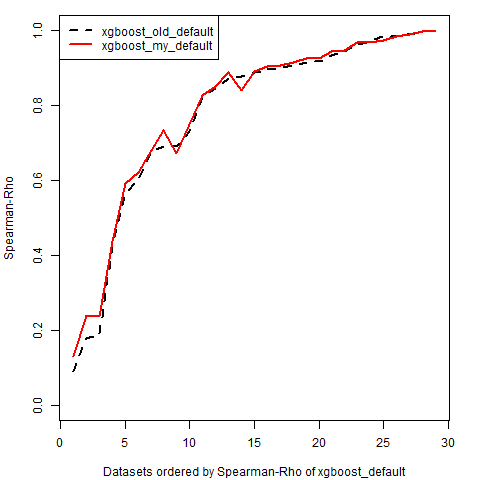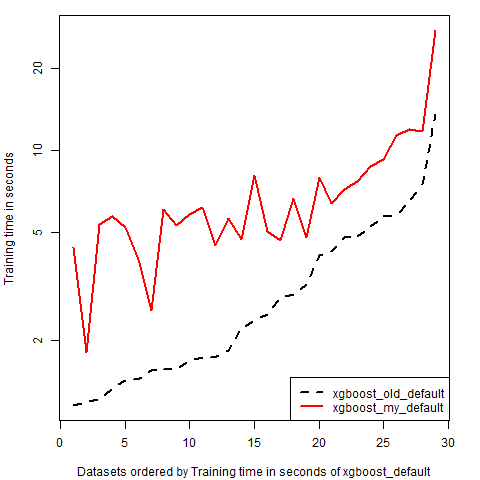New xgboost defaults
xgboost is the most famous R package for gradient boosting and it is since long time on the market. In one of my publications, I created a framework for providing defaults (and tunability measures) and one of the packages that I used there was xgboost. The results provided a default with the parameter nrounds=4168, which leads to long runtimes.
Hence, I wanted to use the data used in the paper to set nrounds to 500 and optimize the other parameters to get optimal defaults.
I used the same method as mentioned in the paper with the 38 classification datasets and obtained the following (rounded) defaults:
| nrounds | —–eta | –subsample | –booster | –max_depth | –min_child_weight |
|---|---|---|---|---|---|
| 500 | 0.052 | 0.87 | gbtree | 11 | 2 |
| –colsample_bytree | –colsample_bylevel |
|---|---|
| 0.71 | 0.64 |
Performance on 29 regression datasets
Now I wanted to know how well this defaults perform on other tasks. So I took a collection of 29 regression tasks of different domains, that I collected from different sources such as OpenML and compared my defaults against the defaults of xgboost with nrounds=500. Code can be seen here.
The results were not really mindblowing. Here you can see performance graphs for two different measures (R-Squared and Spearman’s Rho) using 10 times repeated 5-fold CV:


It is visible that my defaults perform better than the package defaults in most of the cases regarding the R$^2$ and also regarding Spearman’s Rho (a nonparametric measure).
The average values can be seen in the following table:
| –xgboost_old_default | –xgboost_my_default | |
|---|---|---|
| R-squared | 0.610 | 0.645 |
| Spearman Rho | 0.775 | 0.785 |
The percentage of datasets where my new defaults are better than the old defaults is 66% for R$^2$ and 75% for Spearman’s Rho.
So all in all my new defaults do not provide a very big performance gain (on average 0.03 or R$^2$), but seem to be better than the package defaults.
In my paper I could get an average improvement of 0.029 in AUC for the classification datasets with my defaults. Also not a very big difference, so this is not very surprising.
Runtime
The runtime was a bit longer with my defaults, but not really much longer. You can see the runtime below:

The longer runtime is mainly due to the max_depth parameter, which I set bigger (11 instead of 6).
All in all the datasets that I used were rather small, so bigger datasets would provide more interesting results.
Further work
In my next blog entry I will talk a bit about catboost and lightGBM. Especially the first one promises to provide much better default performances than xgboost and I will compare it with the random forest implementation ranger and the support vector machine implementation liquidSVM in their default state.
PS:
I thought again about the results. Some conclusions regarding the parameters:
- In the section with low R-squared the default of xgboost performs much worse than my defaults. These are datasets that are hard to fit and few things can be learned. The higher eta (eta=0.1) leads to too much overfitting compared to my defaults (eta=0.05). If you would set nrounds lower than 500 the effect would be smaller. You could leave eta=0.1 but set nrounds to a lower default value.
- I am not sure how big is the effect for max_depth. In my paper the effect was quite small, so you could leave it on 5 to get better runtimes.
- The subsample and colsample parameters could be safely set to values between 0.6 and 0.8 to get better results.